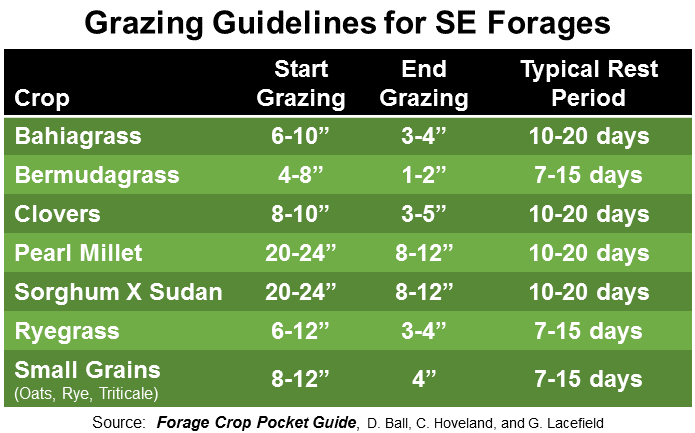
Cheryl Mackowiak, UF/IFAS NFREC Soils Specialist
Forages, as with all plants, require light, water and nutrients. Even if you cannot control water inputs because you are on non-irrigated land, you may find it useful to know the water status of your soils to help estimate yields. Water deficits can lead to slowed growth and stunted plants. The plants may also show symptoms of nutrient deficiency and become increasingly susceptible to pests and diseases.
Field Capacity (FC) is a term used for a well-watered soil that no longer drains after a day. Basically, the gravitational pull downwards is in equilibrium with the ability of the soil pore space to hold water. Field capacity has a suction pressure of −33 J/kg (−0.33 bar), regardless of soil type. Finer textured (heavier) soils can hold more water at FC than coarser, sandier soils, but the plant water requirement is not affected by soil type. In practical terms, planted soils that hold less water (coarse textured soils) can become water deficient more rapidly than finer textured (heavier) soils.
You may wonder how much water your crop is removing from the soil each week and if there is enough water to support optimal forage growth and yield. Many use rain gauges to track rainfall, but not many of us know how much of that rainfall is being taken up or removed by the crop. Evapotranspiration is the sum of evaporation and plant transpiration to the atmosphere. Transpiration is the process of water movement through a plant and its evaporation as water vapor from pores (stomata) in its leaves. When water inputs, via rainfall or irrigation, are less than plant demand (evapotranspirational losses) the soil will become increasingly dry. If this continues for a long enough period (this might be only a few days in Florida), water deficits may develop and the plant will suffer. The greater the deficit, and the longer the period, the worse the effect will be on the plant. If water increases soil suction pressure to -1,500 J/kg (-15 bar), the plant reaches permanent wilting point (PWP) and it will not recover with re-watering.
In Florida and several other states, there are free access, online, weather station sites. In Florida we have Florida Automated Weather Network (FAWN). This site congregates weather data, including rainfall and evapotranspiration (ET), from over 40 sites across the state.The FAWN site provides both rainfall and estimated evapotranspiration on a daily basis. There are also coefficients available that improve the water demand estimates to specific crops at different growth stages, but the ET values from weather stations such as FAWN, are adequate assessments in many cases.
To illustrate how one might use this information, daily ET water loss at Quincy last week was approximately 0.2 inches per day (1.4 inches for the week) but rainfall was only 0.6 inches for the week, so plants were removing more soil moisture than was being replaced through rainfall, which is typical for mid-summer in the southeast. Florida sandy soils at FC may hold about an acre-inch (<1 inch for coarse sand to ~1.2 inches for loamy sands) of plant available water per foot depth of soil. This means that your soil can supply about 4 inches of plant available water in the upper 4 ft of soil. A two week period without rainfall at this time of year might remove 2.8 inches of water through ET. If your roots have a maximum root depth of 2 feet (because of continuous grazing without rest), your forages can suffer significant drought stress during a two week dry spell.
A deeper root system can be achieved by grazing only 50% of standing biomass at a time – “take half leave half”, or by allowing ample recovery time after grazing (2-3 weeks) or haying events (4-5 weeks). Root systems that reach 4 feet or deeper are more likely to survive dry spells of a week or two because their roots can reach deeper soil moisture (4 inches of plant available water in the upper 4 ft of soil versus only 2 inches in the upper 2 ft of soil). Managing your forage crop to grow deeper roots is one of the best ways to survive short-term droughts when irrigation is not available. Those who irrigate forages can replace some of the difference when rainfall falls short of ET. In the above example, there was a 0.8 inch water deficit. It might be wise to irrigate, unless additional rainfall is expected in the coming days. When weekly rainfall exceeds weekly ET, irrigation is not usually necessary.
 0
0

